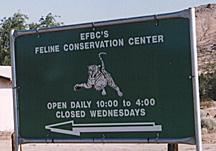
To: Cat Photos / To: Species Information / Back to the Cat House!



Founded in Rosamond in 1977 by private cat-lovers, EFBC's Feline Conservation Center is now a 501 (c) 3 non-profit organization run entirely on public donations. Renewable yearly memberships are the main form of support. We are in the process of a name change from Exotic Feline Breeding Compound (EFBC) to Feline Conservation Center (FCC), so you'll see both names mentioned here. Home to over 60 of the world's most endangered felines, the FCC is recognized by state and federal agencies as a zoo, wildlife museum, and licensed research facility. All funds received are used for the care and support of the compound's animals and long-term goals, which include a research clinic facility, a natural history museum, and public education programs. The older cages are slowly being replaced by large natural habitat enclosures (18k) that rival those found at the best zoos, and in the future a separate small cat compound is envisioned that will house some of the more high-strung species that are not suitable for public display. Enrichment programs keep the cats active. A large gift shop was donated by a local foundation. A new front entranceway with a brick wall and Walk of Honor was one of our recent projects.
EFBC's Feline Conservation Center is part of a worldwide network of zoos and facilities dedicated to the preservation of endangered cats, acting as a modern-day ark in the face of human overpopulation and mass extinction of animal species. FCC's cats are not cast-off circus animals or pets, they are quality breeding animals that are registered within ISIS and the Species Survival Plan (SSP) for each cat species. Cubs born at the FCC are often sent to other zoos for their breeding programs. The FCC does NOT sell cats to the public. General physicals are performed on many of the cats every year, with the bloodwork being used to establish norms for the species.
Cutting-edge breeding research programs at EFBC/FCC have included artificial insemination and in-vitro fertilization, performed on some of the cougars and leopards. While these programs did not result in any cubs, the natural breeding couples have been very active, with 5 cubs born in 1997, 11 cubs born in 1996, and 8 cubs born in 1995. Eventually, in-vitro fertilization could be used to return captive bloodlines to the wild, by capturing a wild female and implanting her with eggs from a captive cat. This approach is an alternative to training a captive-born animal how to survive in the wild.
The EFBC/FCC works directly with special programs at the San Diego Zoo and the University of Tennessee/Knoxville, and is involved in cooperative breeding projects with other zoos and facilities thoughout the world.
In 1990 the American Association of Zookeepers (AAZK) bestowed their Meritorious Achievement Award on EFBC's all-Volunteer Staff in recognition of their outstanding service.

To: Cat Photos / To: Species Information / Back to the Cat House!